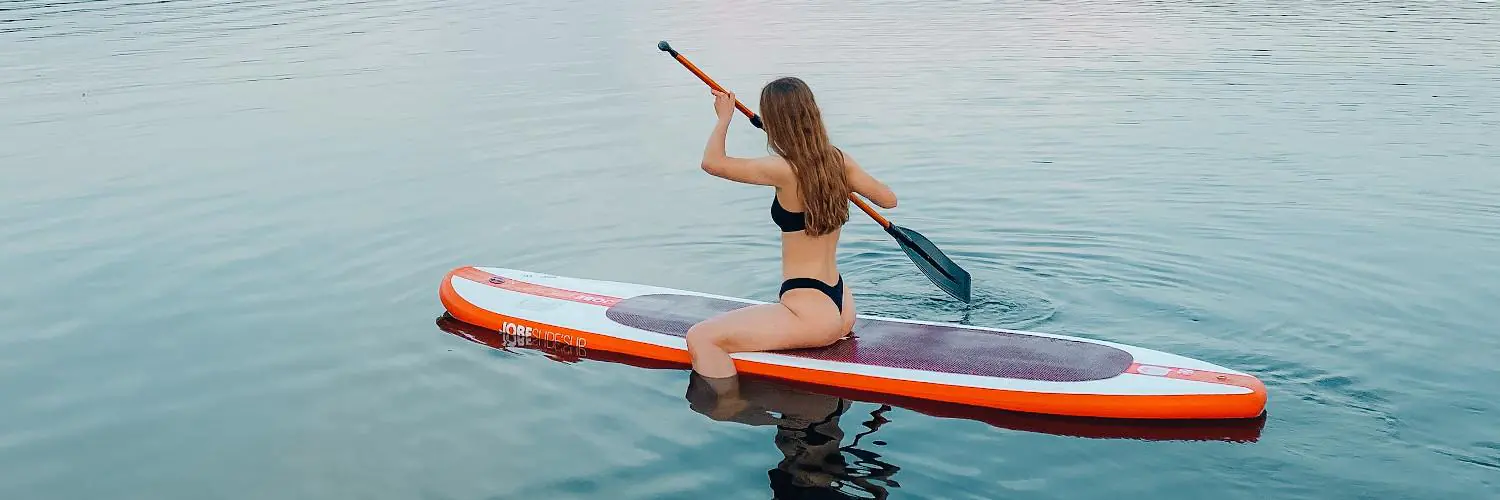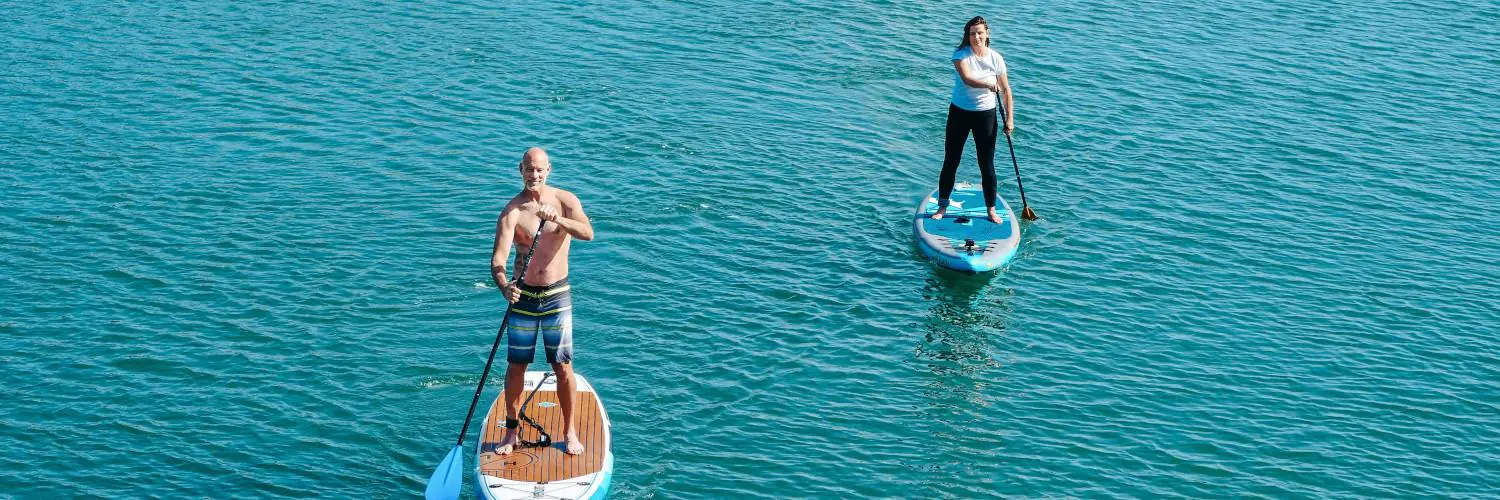Inflatable stand up paddle boards (iSUPs) are really famous now. They are liked by new and old paddlers. While these portable and versatile boards appear almost identical to their traditional rigid counterparts, their construction process is significantly different. Making inflatable stand-up paddleboards (iSUPs) includes picking strong materials, using high-tech methods to make them, and checking them carefully to make sure they last a long time.
At the core of every inflatable stand up paddle board is a strong, airtight material that enables it to maintain its shape when inflated. Usually, this stuff is made of PVC layers and polyester threads mixed together to make a fabric called drop-stitch. This special make not only makes it very stiff but also makes sure the board can handle the pressure and use of paddleboarding in different water conditions.
To further enhance the structural integrity of an iSUP, manufacturers commonly employ a technique called fusion technology. Fusion tech makes PVC layers stick to the drop-stitch fabric with heat. It makes a lighter and greener board than using glue. This makes the board much stronger and with a better finish. It works the best.
Materials and Construction
Drop Stitch Technology
Drop stitch technology is the backbone of inflatable stand-up paddle boards (SUPs) and allows them to maintain their shape and rigidity when inflated. It has many polyester strings connecting the top and bottom of the board. These threads keep the board evenly inflated and make it structurally sound, able to withstand the pressures exerted by the user.
PVC Material
PVC (polyvinyl chloride) is the primary material used in the construction of inflatable SUPs. It is tough, light, strong, sturdy, and water-proof stuff. PVC is used for both the internal drop stitch core and the outer layers of the board.
Layers and Lamination
Inflatable paddle boards have several layers laminated together to create a sturdy structure. The core layer typically consists of drop stitch fabric, while the outer layers are made from PVC material. There are three common types of lamination methods:
- Single Layer: This construction method involves using a single PVC sheet on the top and bottom of the board. While it is lighter and more affordable, single-layer boards may be less durable than their multi-layer counterparts.
- Double Layer: As the name implies, this method involves laminating two layers of PVC on both the top and bottom of the board. This results in increased durability and stiffness compared to single-layer boards, but at the cost of added weight.
- Fusion: The fusion method fuses the PVC layers to the drop stitch core using heat, rather than adhesive. This keeps the board strong and durable and also much lighter.
Inflatable SUPs are often reinforced with additional materials, like fiberglass or carbon fiber, which increase their rigidity and sturdiness even further. Rails, or rims, around the edge of the board can be constructed with extra layers of PVC to protect against punctures and abrasions.
In the end, inflatable stand-up paddle boards give a light, strong, and easy choice for people who like water sports. The mix of drop stitch tech, PVC stuff, and different lamination ways make sure these boards stay in good shape, stiff, and hard to break.
Performance and Quality
Thickness and Rigidity
Inflatable stand up paddle boards are available in various thicknesses ranging from 4 to 6 inches. How thick a board is changes how rigid it can be. Boards with a thickness of 6 inches or more offer better stability and rigidity as compared to thinner boards. Good boards are more dense, and are stronger against damage. Weight capacity also varies with thickness; thicker boards can support heavier riders without affecting the overall performance.
Stability and Maneuverability
The size, shape, and design of inflatable paddle boards are key parts that decide how steady and easy to move they are. Broader boards give more steadiness, so they are good for new paddle boarders. However, boards that are too wide can become challenging to maneuver. But smaller boards respond better and are quicker, letting experts turn easily and do cool moves.
For increased stability, inflatable stand up paddle boards are equipped with fins. Fins make it easier to steer and control where your paddle board goes. Removable fins offer the advantage of customizing the performance and stability based on the user’s skill level and the conditions they are paddle boarding in.
Speed and Glide
The speed and glide of inflatable stand up paddle boards depend on various factors such as shape, length, nose design, and materials used in construction. Boards with a longer, streamlined shape and pointed nose are generally faster and offer smoother gliding than shorter, wider boards.
Epoxy and high-quality PVC materials are commonly used in constructing inflatable stand up paddle boards. Epoxy boards have a solid surface and tend to glide faster, requiring less effort from the paddler. PVC boards, on the other hand, can deliver impressive performance; their buoyancy helps to maintain momentum and speed in various water conditions.
Inflatable stand up paddle boards work well if they are thick, stiff, sturdy, easy to control, fast, and smooth on water. The combination of these elements determines how well a board suits various skill levels, weights, and water conditions.
Transport and Storage
Portability
Inflatable stand up paddle boards (iSUPs) are known for their portability. You can deflate them, put them in a bag, and easily take them to any lake or water area. This compact design is much more convenient compared to traditional hard-shell paddle boards, which often require roof racks or a large vehicle.
- Lightweight: iSUPs typically weigh between 15-30 lbs (7-14 kg), meaning they are simple to lift and carry by one person.
- Deflated size: A deflated iSUP can be rolled up, fitting comfortably into a provided carry bag that may vary in size depending on the board, but generally measures around 35"x12"x12" (90x30x30 cm).
Storage Options
Storing an inflatable stand up paddle board is also more space-efficient compared to rigid models. When the paddle board is not in use, it can be easily deflated and tucked away in a closet or storage room.
When storing an iSUP, it is important to keep it in a dry place, away from direct sunlight, and extreme temperatures – all of which can impact the board’s longevity. Inspecting the board and maintaining it properly will keep it in great condition.
Repair and Maintenance
Routine inspection and proper care can extend the life of an inflatable stand up paddle board (iSUP). Follow these to keep your board in optimal condition.
-
Cleaning: After each use, rinse the iSUP with fresh water to remove sand, salt, or other debris. Use a mild soap and a soft brush to clean the board if necessary. After cleaning, allow the board to air dry completely, avoiding direct sunlight.
-
Inflation: It is crucial to inflate the iSUP to the recommended PSI, which is typically between 12 to 15 PSI. Over-inflating the board can cause damage to the seams and the inner drop-stitch material. Utilize a quality pump and gauge to ensure accurate inflation.
-
Storage: Store your iSUP in a cool, dry place away from direct sunlight and extreme temperatures. Deflate the board by releasing the air from the valve, and then fold or roll it gently to avoid creases and pressure on seams. Use a protective storage bag to safeguard the board from dust and UV exposure.
When it comes to repairs, iSUPs are generally durable and can survive minor accidents. However, punctures, tears, or seam damage can occur. Here are some steps to address these issues:
-
Punctures and Tears: Use a repair kit that includes adhesive and patches specifically designed for iSUPs. Clean and dry the damaged area, then apply the adhesive and patch, ensuring a firm bond. Allow the repair to cure for at least 24 hours before inflating and using the iSUP.
-
Seam Repairs: If a seam is damaged, seek professional help, as improper repair can result in further damage and reduced performance. Consult the manufacturer or a local iSUP repair specialist for assistance.
Regular preventative maintenance and diligent care of your iSUP can minimize the risk of damage and keep your paddle board looking and functioning like new for years to come.
Extra Functions
Inflatable stand up paddle boards (iSUPs) offer a range of extra functions that enhance the paddling experience. One such feature is the addition of bungee cords on the board’s deck. These help to keep things in place like a bag or bottle when on the water.
Manufacturers often equip iSUPs with strategically placed handles for easy transportation. These handles not only make carrying the board to and from the water more manageable but also assist with re-entry onto the paddle board when in deeper waters.
Another good thing on inflatable paddle boards are D-rings. These rings are often on the sides or back of the board. A safety leash, other boards, or even more gear can be connected thru them. D-rings are typically made of durable stainless steel to withstand wear and tear from constant use.
A popular extra function found in most iSUPs is the integrated deck pad. Deck pads mostly helps with grip, making it less slippery when used. This makes it easier stand right and stay steady on the board. The pads are usually made from non-slippy stuff like EVA foam and are available in different feels and designs to fit what each person likes.
To cater to different activities and skill levels, many iSUPs have removable fins. By changing the fin setup, people can change the board’s performance for their use, whether for relaxed paddles on quiet waters or handling tougher conditions.
Price and Selection
Cost Factors
When considering an inflatable stand-up paddleboard, several factors influence its price:
- Material quality: Higher quality materials, such as military-grade PVC, contribute to increased durability and longevity, but also come with a higher price tag.
- Board size: Larger boards tend to be more expensive due to the additional material and construction efforts.
- Accessories: Many inflatable paddleboards come with essential accessories, such as paddles, air pumps, and carrying bags. These can change the cost.
- Brand reputation: Renowned brands might charge a premium for their expertise and track record in the industry.
You should have these in mind when thinking of the cost factors when evaluating the price range of inflatable paddleboards.
Choosing the Right Board
Selecting the right inflatable stand-up paddleboard depends on the individual’s needs and skill level.
- Beginners: For those new to paddleboarding, a wider and longer board can offer increased stability and be more forgiving. These boards are usually designed with beginners in mind and often are more affordable.
- Intermediate paddlers: As skills improve, a paddler might look for a board with better performance features such as increased speed and maneuverability. Boards in this category could be slightly more expensive.
- Advanced paddlers: For experienced individuals, specialized boards designed for speed, touring, or other specific activities might be desired. These can be more expensive because their features are more unique.
Selecting the right board depends on factors like their materials, size, extras, and the brand. Additionally, choosing the right board for one’s skill level, from beginner to advanced, should be considered when making a purchase. Remember to evaluate each factor while considering personal needs and budget constraints.








